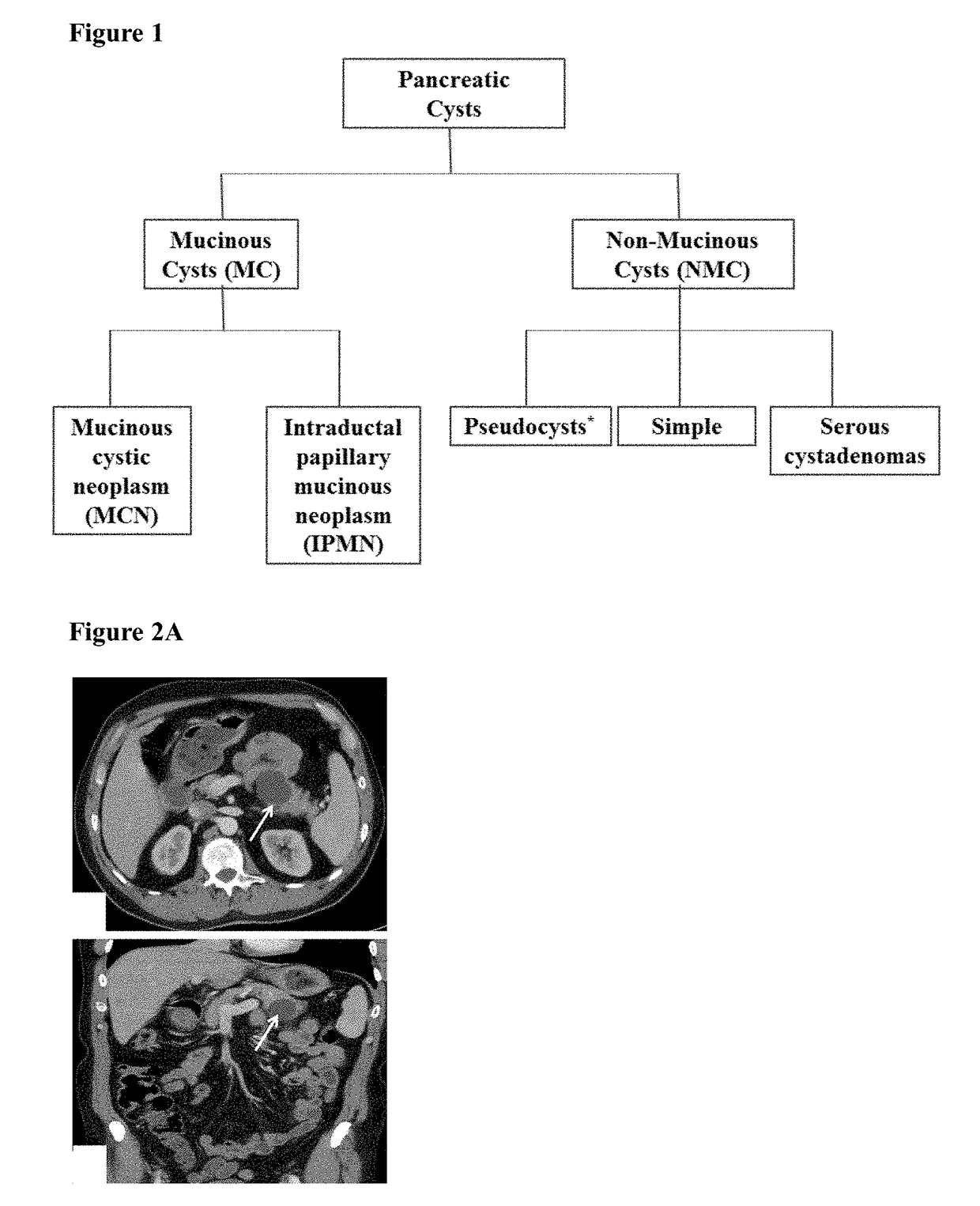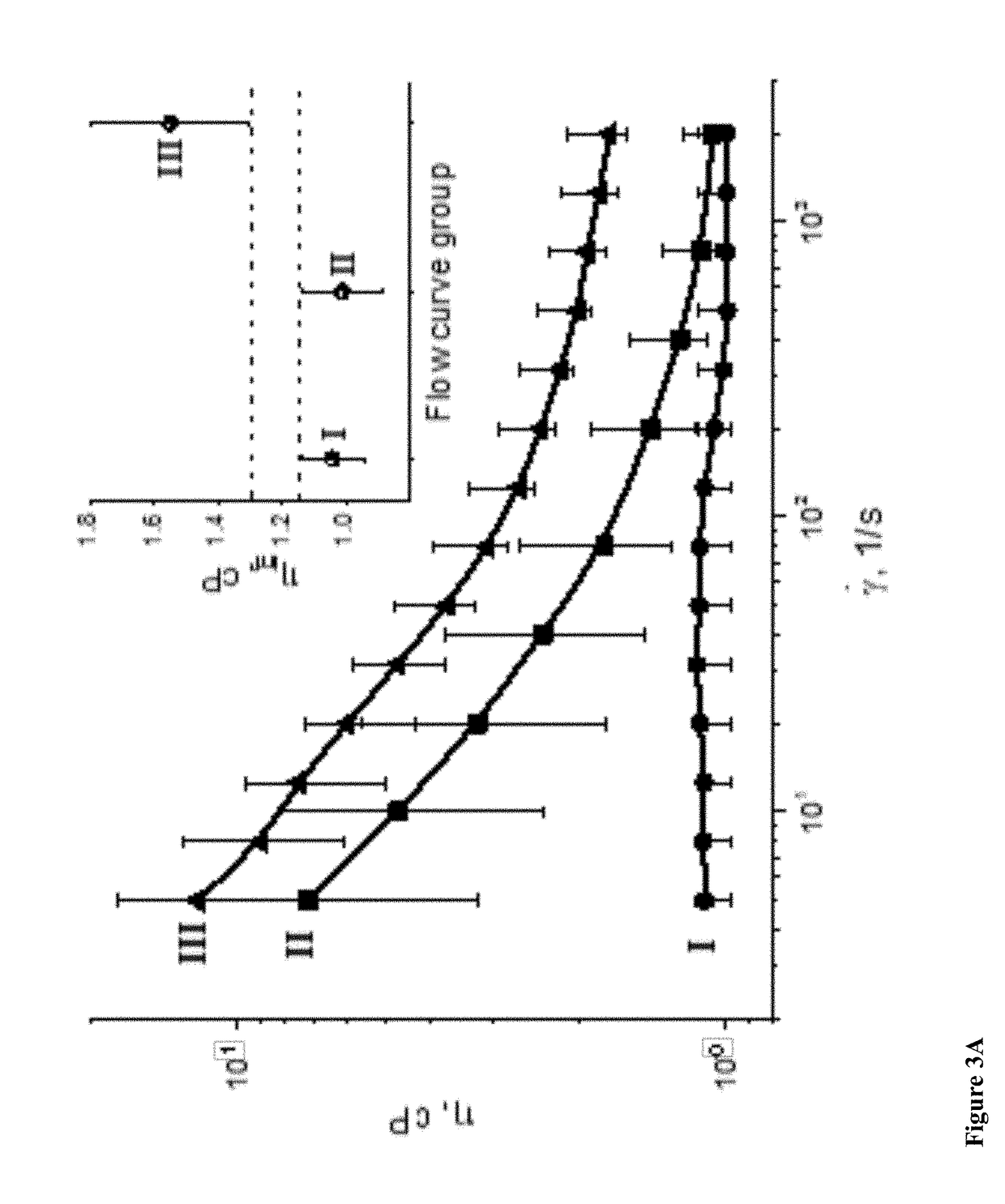Cyst fluid viscosity as a marker for malignancy
a cyst and fluid technology, applied in the field of cyst malignancy determination, can solve the problems of inability to accurately differentiate between pancreatic cyst types, inability to diagnose accurately, and inability to accurately diagnose mcn, etc., and achieve the effect of greater accuracy
- Summary
- Abstract
- Description
- Claims
- Application Information
AI Technical Summary
Benefits of technology
Problems solved by technology
Method used
Image
Examples
example 1
Patient Cysts Assessment
[0102]A total of 22 patients (mean age: 57.1 years [SD=16.2], Table 1) underwent endoscopic ultrasound-guided fine needle aspiration (EUS-FNA); cyst fluids were sent for cytological, biochemical and rheological assessments. Cysts were classified as MC (mucinous cystadenoma, mucinous adenocarcinoma, IPMN) or NMC (serous cystadenoma, pseudocyst), based on surgical and / or clinical findings (presentation, follow-up, imaging and fluid analyses). The baseline patient characteristics, the diameter of the cyst, the location of the cyst in the pancreas, the level of tumor markers (CEA, amylase), results of the cytological examination, string sign and rheological measurements are presented in Table 2. Overall, 10 lesions (45.45%) were classified as MC, while 12 (54.54%) were classified as NMC, 5 of which (22.72%) were considered pseudocysts.
TABLE 1Patient age and various features of PCF samplesNumberMean ± SDMedian (range)P valueAge22 (total)57.1 ± 16.257(21-78)MC1069....
example 2
Rheological Assessment
[0103]For the rheological assessment, the extracted fluids were evaluated by both string-sign test and viscosity measurements. Flow curves were drawn up, with the viscosity, η, plotted against the shear rate, {dot over (γ)}. In order to describe PCF behavior across the range of shear rates, a power law model was employed:
η=η∞+K·{dot over (γ)}n (1)
where, K and n are the fitting parameters and η∞ is treated as infinite viscosity.
[0104]This power law, also known as the Ostwald-de Waele power law, is typically used to describe the behavior of non-Newtonian fluids. For example, if n∞) (Table 3), resulted in three types of flow curves (I, II, III) (FIG. 3A). More detailed information, including flow curves, as well as the values of K, n and η∞ for each of the tested PCF samples, is provided herein (FIG. 3B and Table 4, respectively). At infinite shear rate, {dot over (γ)}∞, type II and I flow curves demonstrated nearly similar low viscosity, η∞=1.01 cP and η∞=1.04 c...
example 3
Diagnostic Capacity of Tested Factors
[0105]For the purpose of comparing between predictive factors in their diagnostic capacity to differentiate between mucinous and non-mucinous PCFs, the statistical significance of mean values measured for flow curve types I and II versus III are presented in Table 5. It can be seen that CEA levels were significantly lower among NMCs as compared to MCs (pc values were significantly different between type I and II lesions versus type III lesions (p<0.0001).
TABLE 5Mean values of predictive factors in PCF sample subgroupsFlow curveNumberMean ± SDMedian (range)P valueAge (60 y)22 (total)57.1 ± 16.257(21-78)I 355.3 ± 11.452(46-68)II1150.4 ± 16.855(21-75)I + II1451.4 ± 15.554(21-75)0.020III 8 7 ± 12.973.5(47-78)Amylase (U / L)22 (total) 72216 ± 1655181694(22-737000)I 323467 ± 381462896(22-67483)II1159597 ± 944883833(29-282240)I + II1451855 ± 856053365(22-282240)0.297III 8107847 ± 257487279(33-737000)CEA (ng / mL)22 (total) 6656 ± 2242926(0-103970)I 3273 ± ...
PUM
| Property | Measurement | Unit |
|---|---|---|
| viscosity | aaaaa | aaaaa |
| viscosity | aaaaa | aaaaa |
| threshold viscosity | aaaaa | aaaaa |
Abstract
Description
Claims
Application Information
 Login to View More
Login to View More - R&D
- Intellectual Property
- Life Sciences
- Materials
- Tech Scout
- Unparalleled Data Quality
- Higher Quality Content
- 60% Fewer Hallucinations
Browse by: Latest US Patents, China's latest patents, Technical Efficacy Thesaurus, Application Domain, Technology Topic, Popular Technical Reports.
© 2025 PatSnap. All rights reserved.Legal|Privacy policy|Modern Slavery Act Transparency Statement|Sitemap|About US| Contact US: help@patsnap.com



